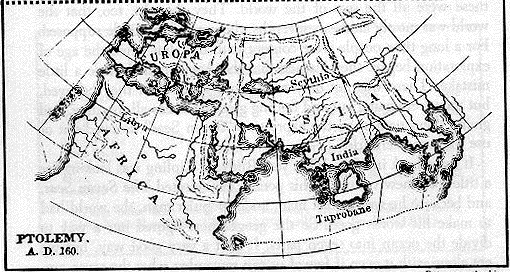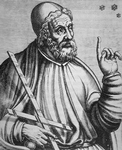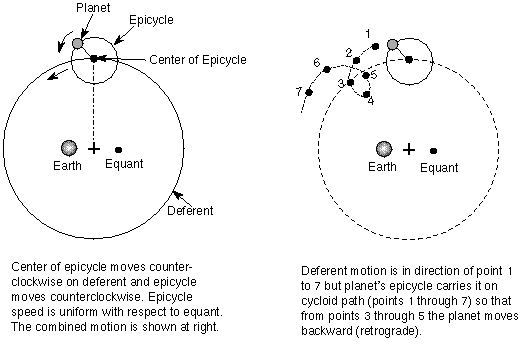Video lecture for this chapter
This material (including images) is copyrighted!.
See my copyright notice for fair use
practices. Select the photographs to display the original source in
another window.
Plato gave his students a major problem to work on. Their task was to find a
geometric explanation for the apparent motion of the planets, especially
the strange retrograde motion. One key observation: as a planet undergoes
retrograde motion (drifts westward with respect to the stars), it becomes brighter.
Plato and his students were, of course, also guided by the
Pythagorean Paradigm. This meant that regardless of the scheme they came up with,
the Earth should be at the unmoving center of the planet motions. One student named
Aristarchus violated that rule and developed a model with the Sun at the center.
His model was not accepted because of the obvious observations against a moving
Earth.
Some of the observations that convinced the Greeks that the Earth was
not moving are
- The Earth is not part of the heavens. Today the Earth is known to be just
one planet of eight (plus 5 dwarf planets at the time of writing) that orbit an average star in the outskirts of a large galaxy, but
this idea gained acceptance only recently when telescopes extended our vision.
- The celestial objects are bright points of light while the Earth is an
immense, nonluminous sphere of mud and rock. Modern astronomers now know that the stars are
objects like our Sun but very far away and the planets are just reflecting
sunlight.
- The Greeks saw little change in the heavens---the stars are the same night after night.
In contrast to this, they saw the Earth as the home of birth, change, and destruction. They
believed that the celestial bodies have an immutable
regularity that is never achieved on the corruptible Earth. Today astronomers know that
stars are born and eventually die (some quite spectacularly!)---the length of
their lifetimes are much more than a human lifetime so they appear unchanging.
Also, modern astronomers know that the stars do change positions with respect to each other
over, but without a telescope, it takes hundreds of years to notice the
slow changes.
- Finally, our senses show that the Earth appears to be stationary!
Air, clouds, birds, and other things unattached to the ground are not left
behind as they would be if the Earth was moving. There should be a strong wind
if the Earth were spinning as suggested by some radicals. There is no strong wind.
If the Earth were moving, then anyone jumping from a high point would
hit the Earth far behind from the point where the leap began. Furthermore, they knew
that things can be flung off an object that is spinning rapidly. The observation that
rocks, trees, and people are not hurled off the Earth proved to them that the Earth was
not moving. Today we have the
understanding of inertia and forces that explains why this does not happen even
though the Earth is spinning and orbiting the Sun. That understanding, though, developed
about 2000 years after Plato.
Plato taught that since an infinite number of
theories can be constructed to account for the observations, we can never empirically answer
what the universe is really like. He said that we should adopt an
instrumentalist
view: scientific theories are just tools or calculation devices and are
not to
be interpreted as real. Any generalizations we make may be shown to be false in the future
and, also, some of our false generalizations can actually ``work''--an
incorrect theory can explain the observations (see the
scientific method page for
background material on this).
 Aristotle (lived 384--322 B.C.E.) was a student of Plato and had
probably the
most significant influence on many fields of studies (science, theology, philosophy,
etc.) of any single person in history. He thought that Plato had gone too far with
his instrumentalist view of theories. Aristotle taught a realist view:
scientific, mathematical tools are not merely tools---they characterize the way the
universe actually is. At most one model is correct. The model he chose was one
developed by another follower of Plato, Eudoxus. The planets and stars were on concentric
crystalline spheres centered on the Earth. Each planet, the Sun, and the Moon were on
their own sphere. The stars were placed on the largest sphere surrounding all of the rest.
Aristotle (lived 384--322 B.C.E.) was a student of Plato and had
probably the
most significant influence on many fields of studies (science, theology, philosophy,
etc.) of any single person in history. He thought that Plato had gone too far with
his instrumentalist view of theories. Aristotle taught a realist view:
scientific, mathematical tools are not merely tools---they characterize the way the
universe actually is. At most one model is correct. The model he chose was one
developed by another follower of Plato, Eudoxus. The planets and stars were on concentric
crystalline spheres centered on the Earth. Each planet, the Sun, and the Moon were on
their own sphere. The stars were placed on the largest sphere surrounding all of the rest.
Aristotle chose this model because most popular and observational evidence supported it
and his physics and theory of motion necessitated a geocentric
(Earth-centered) universe. In his theory of motion, things naturally move to the
center of the Earth and
the only way to deviate from that is to have a force applied to the object.
So a ball
thrown parallel to the ground must have a force continually pushing it along.
This idea was unchallenged for almost two thousand years until Galileo showed
experimentally that things will not move or change their motion unless a force
is applied. Also, the crystalline spheres model agreed with the Pythagorean paradigm of
uniform, circular motion (see the previous
section).
A slight digression: Another conclusion drawn from Aristotle's teachings was that the Earth was unique with its own set of physical laws that were different from how things worked in the heavens. The Earth was a world and filled with change and decay while the planets, Moon, and Sun were perfect, unchanging and essentially ornaments on the sky, not worlds that could be explored. (Imagine the transformation of our viewpoint when we discovered using telescopes that those wandering points of light are worlds like the Earth and then later discovered other planets orbiting other stars!)
Now, to return to the motions of the planets...
Astronomers continued working on models of
how the planets moved. In order to explain the retrograde motion some models used
epicycles---small circles attached to larger circles centered on the Earth. The
planet was on the epicycle so it executed a smaller circular motion as it moved around the
Earth. This meant that the planet's distance from us changed and if the epicyclic motion
was in the same direction (e.g., counter-clockwise) as the overall motion around the Earth,
the planet would be closer to the Earth as the epicycle carried the planet backward with
respect to the usual eastward motion. This explained why planets are brighter as they
retrogress.

Ptolemy's view of the world. Select the image to go to Jim Siebold's ancient
maps database from which this picture came (will display in another window).
 Ptolemy
(lived 85--165 C.E.) set out to
finally solve the problem of the planets motion.
He combined the best features of the geocentric models that used epicycles with the most
accurate observations of the planet positions to create a model that would last for
nearly 1500 years. He added some refinements to explain the
details of the observations: an ``eccentric'' for each planet that was the true center
of its motion (not the Earth!) and an ``equant'' about which each planet moved uniformly in
relation to (not the Earth!). See the figure below for a diagram of this setup.
Ptolemy
(lived 85--165 C.E.) set out to
finally solve the problem of the planets motion.
He combined the best features of the geocentric models that used epicycles with the most
accurate observations of the planet positions to create a model that would last for
nearly 1500 years. He added some refinements to explain the
details of the observations: an ``eccentric'' for each planet that was the true center
of its motion (not the Earth!) and an ``equant'' about which each planet moved uniformly in
relation to (not the Earth!). See the figure below for a diagram of this setup.

Select image to show animation of retrograde motion.
These refinements were incompatible with Aristotle's model and the Pythagorean paradigm---a
planet on an epicycle would crash into its crystalline sphere and the motion is
not truly centered on the Earth. So Ptolemy adopted an instrumentalist view---this strange
model is only an accurate calculator to predict the planet motions but the
reality is Aristotle's model. This apparent contradiction between reality and
a calculation device was perfectly fine in his time. Our modern belief that models must
characterize the way the universe actually is is a tribute to the even longer-lasting
influence of Aristotle's realism. Ptolemy was successful in having people adopt his
model because he gathered the best model pieces together, used the most
accurate observations and he published his work in a large 13-volume series called
the ``Almagest'', ensuring that his ideas would last long after he died.
 Go back to previous section --
Go back to previous section --
 Go to next section
Go to next section
last updated:
January 21, 2022
Is this page a copy of Strobel's
Astronomy Notes?
Author of original content:
Nick Strobel
 Aristotle (lived 384--322 B.C.E.) was a student of Plato and had
probably the
most significant influence on many fields of studies (science, theology, philosophy,
etc.) of any single person in history. He thought that Plato had gone too far with
his instrumentalist view of theories. Aristotle taught a realist view:
scientific, mathematical tools are not merely tools---they characterize the way the
universe actually is. At most one model is correct. The model he chose was one
developed by another follower of Plato, Eudoxus. The planets and stars were on concentric
crystalline spheres centered on the Earth. Each planet, the Sun, and the Moon were on
their own sphere. The stars were placed on the largest sphere surrounding all of the rest.
Aristotle (lived 384--322 B.C.E.) was a student of Plato and had
probably the
most significant influence on many fields of studies (science, theology, philosophy,
etc.) of any single person in history. He thought that Plato had gone too far with
his instrumentalist view of theories. Aristotle taught a realist view:
scientific, mathematical tools are not merely tools---they characterize the way the
universe actually is. At most one model is correct. The model he chose was one
developed by another follower of Plato, Eudoxus. The planets and stars were on concentric
crystalline spheres centered on the Earth. Each planet, the Sun, and the Moon were on
their own sphere. The stars were placed on the largest sphere surrounding all of the rest.

 Ptolemy
(lived 85--165 C.E.) set out to
finally solve the problem of the planets motion.
He combined the best features of the geocentric models that used epicycles with the most
accurate observations of the planet positions to create a model that would last for
nearly 1500 years. He added some refinements to explain the
details of the observations: an ``eccentric'' for each planet that was the true center
of its motion (not the Earth!) and an ``equant'' about which each planet moved uniformly in
relation to (not the Earth!). See the figure below for a diagram of this setup.
Ptolemy
(lived 85--165 C.E.) set out to
finally solve the problem of the planets motion.
He combined the best features of the geocentric models that used epicycles with the most
accurate observations of the planet positions to create a model that would last for
nearly 1500 years. He added some refinements to explain the
details of the observations: an ``eccentric'' for each planet that was the true center
of its motion (not the Earth!) and an ``equant'' about which each planet moved uniformly in
relation to (not the Earth!). See the figure below for a diagram of this setup.
